-

新人教版高中英语选修2Unit 3 Reading for writing教学设计
The theme of this part is to write an article about healthy diet. Through reading and writing activities, students can accumulate knowledge about healthy diet, deepen their understanding of the theme of healthy diet, and reflect on their own eating habits. This text describes the basic principles of healthy diet. The author uses data analysis, definition, comparison, examples and other methods. It also provides a demonstration of the use of conjunctions, which provides important information reference for students to complete the next collaborative task, writing skills, vivid language materials and expressions.1. Teach Ss to learn and skillfully use the new words learned from the text.2. Develop students’ ability to understand, extract and summarize information.3. Guide students to understand the theme of healthy diet and reflect on their own eating habits.4. To guide students to analyze and understand the reading discourse from the aspects of theme content, writing structure, language expression, etc., 5. Enable Ss to write in combination with relevant topics and opinions, and to talk about their eating habits.1. Guide students to analyze and understand the reading discourse from the aspects of theme content, writing structure, language expression, etc.2. Enable them to write in combination with relevant topics and opinions, and to talk about their eating habits.3. Guide the students to use the cohesive words correctly, strengthen the textual cohesion, and make the expression fluent and the thinking clear.Step1: Warming upbrainstorm some healthy eating habits.1.Eat slowly.2.Don’t eat too much fat or sugar.3.Eat healthy food.4.Have a balanced diet.Step2: Read the passage and then sum up the main idea of each paragraph.

新人教版高中英语选修2Unit 2 Reading for writing教学设计
The theme of this section is to express people's views on studying abroad. With the continuous development of Chinese economic construction, especially the general improvement of people's living standards, the number of Chinese students studying abroad at their own expense is on the rise. Many students and parents turn their attention to the world and regard studying abroad as an effective way to improve their quality, broaden their horizons and master the world's advanced scientific knowledge, which is very important for the fever of going abroad. Studying abroad is also an important decision made by a family for their children. Therefore, it is of great social significance to discuss this issue. The theme of this section is the column discussion in the newspaper: the advantages and disadvantages of studying abroad. The discourse is about two parents' contribution letters on this issue. They respectively express their own positions. One thinks that the disadvantages outweigh the advantages, and the other thinks that the advantages outweigh the disadvantages. The two parents' arguments are well founded and logical. It is worth noting that the two authors do not express their views on studying abroad from an individual point of view, but from a national or even global point of view. These two articles have the characteristics of both letters and argumentative essays1.Guide the students to read these two articles, and understand the author's point of view and argument ideas2.Help the students to summarize the structure and writing methods of argumentative writing, and guides students to correctly understand the advantages and disadvantages of studying abroad3.Cultivate students' ability to analyze problems objectively, comprehensively and deeply

新人教版高中英语选修2Unit 2 Using langauge-Listening教学设计
? B: Absolutely! Getting involved with Chinese cultural activities there definitely helped a lot. I got to practice my Chinese on a daily basis, and I could learn how native Chinese speakers spoke.? A: What do you feel is your biggest achievement?? B: Learning Chinese characters! I have learnt about 1,500 so far. When I first started, I didn't think it was even going to be possible to learn so many, but now I find that I can read signs, menus, and even some easy newspaper articles.? A: What are you most keen on?? B: I've really become keen on learning more about the Chinese culture, in particular Chinese calligraphy. As I have learnt Chinese characters, I have developed a great appreciation for their meaning. I want to explore Chinese characters by learning how to write them in a more beautiful way. ? A: Finally, what do you want to say to anyone interested in learning Chinese?? I have really become keen on learning more about the Chinese culture, in particular Chinese Calligraphy. As I have learnt Chinese character, I have developed a great appreciation for their meaning. I want to explore Chinese characters by learning how to write them in a more beautiful way.? A: Finally, what do you want to say to anyone interested in learning Chinese?? B: I'd say, give it a shot! While some aspects may be difficult, it is quite rewarding and you will be happy that you tried.? A: Thanks for your time. ? B:You're welcome.

新人教版高中英语选修2Unit 3 Using langauge-Listening教学设计
1. How is Hunan cuisine somewhat different from Sichuan cuisine?The heat in Sichuan cuisine comes from chilies and Sichuan peppercorns. Human cuisine is often hotter and the heat comes from just chilies.2.What are the reasons why Hunan people like spicy food?Because they are a bold people. But many Chinese people think that hot food helps them overcome the effects of rainy or wet weather.3.Why do so many people love steamed fish head covered with chilies?People love it because the meat is quite tender and there are very few small bones.4.Why does Tingting recommend bridge tofu instead of dry pot duck with golden buns?Because bridge tofu has a lighter taste.5 .Why is red braised pork the most famous dish?Because Chairman Mao was from Hunan, and this was his favorite food.Step 5: Instruct students to make a short presentation to the class about your choice. Use the example and useful phrases below to help them.? In groups of three, discuss what types of restaurant you would like to take a foreign visitor to, and why. Then take turns role-playing taking your foreign guest to the restaurant you have chosen. One of you should act as the foreign guest, one as the Chinese host, and one as the waiter or waitress. You may start like this:? EXAMPLE? A: I really love spicy food, so what dish would you recommend?? B: I suggest Mapo tofu.? A: Really ? what's that?

新人教版高中英语选修2Unit 4 Learning about Language教学设计
This section guides students to pay attention to the typical context of vocabulary use, helps students accumulate vocabulary around the key vocabulary of this unit, and uses the learned words and word chunks in different contexts to deeply understand their meaning and usage, so as to achieve the purpose of review and consolidation.The teaching design activities aim to guide students to pay attention to the typical context in which the target vocabulary is used, as well as the common vocabulary used in collocation, so that students can complete the sentence with correct words. In terms of vocabulary learning strategies, this unit focuses on cultivating students' ability to pay attention to collocation of words and to use word blocks to express meaning.For vocabulary learning, it is not enough just to know the meaning of a single word, but the most important thing is to master the common collocations of words, namely word blocks.Teachers should timely guide students to summarize common vocabulary collocation, such as verb and noun collocation, verb and preposition collocation, preposition and noun collocation, and so on.1. Guide students to understand and consolidate the meaning and usage of the vocabulary in the context, 2. Guide the students to use the unit topic vocabulary in a richer context3. Let the students sort out and accumulate the accumulated vocabulary, establishes the semantic connection between the vocabulary,4. Enable students to understand and master the vocabulary more effectivelyGuiding the Ss to use unit topic words and the sentence patterns in a richer context.

新人教版高中英语选修2Unit 4 Reading for writing教学设计
假定你是英国的Jack,打算来中国旅行,请你给你的中国笔友李华写一封信,要点如下:1.你的旅行计划:北京→泰山→杭州;2.征求建议并询问他是否愿意充当你的导游。注意:1.词数80左右(开头和结尾已给出,不计入总词数);2.可以适当增加细节,以使行文连贯。参考词汇:故宫 the Forbidden City;泰山 Mount TaiDear Li Hua,I'm glad to tell you that 'm going to visit China.First,I am planning to visit Beijing,the capitalof China,where I am looking forward to enjoying the Great Wall,the Forbidden City and somebeautiful parks.Then I intend to go to visit Mount Tai in Shandong Province.I've heard that it is one ofthe most famous mountains in China and I can't wait to enjoy the amazing sunrise there.After that,I amalso going to Hangzhou.It is said that it is a beautiful modern city with breathtaking natural sights,among which the West Lake is a well- known tourist attraction.What do you think of my travel plan? Will you act as my guide? Hope to hear from you soon.

新人教版高中英语选修2Unit 4 Using langauge-Listening教学设计
The theme of the listening section is " talking about scenery and culture along a journey."The part is designed to further lead the students to understand Canadian natural geography and social environment, and integrated into the cultural contrast by mentioning the long train journey from Beijing to Moscow routes. On this basis, the part activates students related travel experience, lets the student serial dialogue, guides the student to explore further the pleasure and meaning of the long journey, and Chinese and foreign cultural comparison.The part also provides a framework for the continuation of the dialogue, which is designed to provide a framework for students to successfully complete their oral expressions, and to incorporate an important trading strategy to end the dialogue naturally.1. Help students to understand and master some common English idioms in the context, and experience the expression effect of English idioms.2. Guide the students to understand the identity of different people in the listening context, and finish the dialogue according to their own experience.3. Instruct the students to use appropriate language to express surprise and curiosity about space and place in the dialogue, and master the oral strategy of ending the dialogue naturally.1. Instruct students to grasp the key information and important details of the dialogue.2. Instruct students to conduct a similar talk on the relevant topic.

新人教版高中英语选修2Unit 5 Learning about Language教学设计
The purpose of this section of vocabulary exercises is to consolidate the key words in the first part of the reading text, let the students write the words according to the English definition, and focus on the detection of the meaning and spelling of the new words. The teaching design includes use English definition to explain words, which is conducive to improving students' interest in vocabulary learning, cultivating their sense of English language and thinking in English, and making students willing to use this method to better grasp the meaning of words, expand their vocabulary, and improve their ability of vocabulary application. Besides, the design offers more context including sentences and short passage for students to practice words flexibly.1. Guide students to understand and consolidate the meaning and usage of the vocabulary in the context, 2. Guide the students to use the unit topic vocabulary in a richer context3. Let the students sort out and accumulate the accumulated vocabulary, establishes the semantic connection between the vocabulary,4. Enable students to understand and master the vocabulary more effectivelyGuiding the Ss to use unit topic words and the sentence patterns in a richer context.Step1: Read the passage about chemical burns and fill in the blanks with the correct forms of the words in the box.

新人教版高中英语选修2Unit 5 Reading and thinking教学设计
The theme of this activity is to learn the first aid knowledge of burns. Burns is common in life, but there are some misunderstandings in manual treatment. This activity provides students with correct first aid methods, so as not to take them for granted in an emergency. This section guides students to analyze the causes of scald and help students avoid such things. From the perspective of text structure and collaborative features, the text is expository. Expository, with explanation as the main way of expression, transmits knowledge and information to readers by analyzing concepts and elaborating examples. This text arranges the information in logical order, clearly presents three parts of the content through the subtitle, accurately describes the causes, types, characteristics and first aid measures of burns, and some paragraphs use topic sentences to summarize the main idea, and the level is very clear.1. Guide students to understand the causes, types, characteristics and first aid methods of burns, through reading2. Enhance students’ ability to deal withburnss and their awareness of burns prevention3. Enable students to improve the ability to judge the types of texts accurately and to master the characteristics and writing techniques of expository texts.Guide students to understand the causes, types, characteristics and first aid methods of burns, through readingStep1: Lead in by discussing the related topic:1. What first-aid techniques do you know of ?CPR; mouth to mouth artificial respiration; the Heimlich Manoeuvre

新人教版高中英语选修2Unit 5 Using langauge-Listening教学设计
The theme of this section is to learn how to make emergency calls. Students should learn how to make emergency calls not only in China, but also in foreign countries in English, so that they can be prepared for future situations outside the home.The emergency telephone number is a vital hotline, which should be the most clear, rapid and effective communication with the acute operator.This section helps students to understand the emergency calls in some countries and the precautions for making emergency calls. Through the study of this section, students can accumulate common expressions and sentence patterns in this context. 1.Help students accumulate emergency telephone numbers in different countries and learn more about first aid2.Guide the students to understand the contents and instructions of the telephone, grasp the characteristics of the emergency telephone and the requirements of the emergency telephone.3.Guide students to understand the first aid instructions of the operators.4.Enable Ss to make simulated emergency calls with their partners in the language they have learned1. Instruct students to grasp the key information and important details of the dialogue.2. Instruct students to conduct a similar talk on the relevant topic.Step1:Look and discuss:Match the pictures below to the medical emergencies, and then discuss the questions in groups.
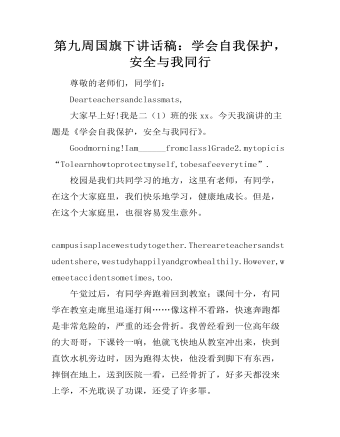
第九周国旗下讲话稿:学会自我保护,安全与我同行
尊敬的老师们,同学们:Dearteachersandclassmats,大家早上好!我是二(1)班的张xx。今天我演讲的主题是《学会自我保护,安全与我同行》。Goodmorning!Iam______fromclass1Grade2.mytopicis“Tolearnhowtoprotectmyself,tobesafeeverytime”.校园是我们共同学习的地方,这里有老师,有同学,在这个大家庭里,我们快乐地学习,健康地成长。但是,在这个大家庭里,也很容易发生意外。campusisaplacewestudytogether.Thereareteachersandstudentshere,westudyhappilyandgrowhealthily.However,wemeetaccidentsometimes,too.午觉过后,有同学奔跑着回到教室;课间十分,有同学在教室走廊里追逐打闹……像这样不看路,快速奔跑都是非常危险的,严重的还会骨折。我曾经看到一位高年级的大哥哥,下课铃一响,他就飞快地从教室冲出来,快到直饮水机旁边时,因为跑得太快,他没看到脚下有东西,摔倒在地上,送到医院一看,已经骨折了,好多天都没来上学,不光耽误了功课,还受了许多罪。

第九周国旗下讲话稿:增强安全意识,学会自我保护
同学们,老师们:大家早上好!今天我国旗下讲话的题目是《增强安全意识,学会自我保护》。同学们,安全无小事,事事须小心。增强安全意识,学会自我保护,是杜绝安全事故发生的最好法宝。然而,我们许多同学思想上、心理上和行为上都忽视了安全工作的重要性。据中国青少年研究中心的全国性大型调查发现,安全事故已经成为14岁以下少年儿童的第一死因,并有逐年增加的趋势;全国每年约有1.6万名中小学生非正常死亡,平均每天有40多人,就是说几乎每天有一个班的学生从我们这个世界“消失”!一个个触目惊心、血泪交织的悲剧叫人扼腕叹息、心有余悸,更对我们敲响了安全的警钟。安全关系着我们的生命与健康,切不可麻痹大意。因此,我们一定要增强安全防范意识,提高自我保护能力。首先,要充分认识安全的重要性,树立高度的安全意识。在对待安全问题的态度上,有一种思想特别要不得!那就是认为提高安全意识,实施安全行为,是胆小怕事;而胆大妄为,敢于冒险是勇敢!这种思想是完全错误的!存在这种思想的人往往好出风头,不听教导,也最容易发生安全事故。比如,在公路上飞车的大多会发生交通事故,手持鞭炮燃放的大多会被炸伤,喜欢追逐打闹的大多会发生碰撞事故,喜欢舞刀弄枪的往往会造成伤害……

本学期第十九周国旗下讲话暨“周恩来班”交接仪式
本学期第十九周国旗下讲话暨周恩来班交接仪式薪火相传,后继有人老师们,同学们,大家早上好。去年年底,我们高三(7)班很荣幸被授予省“周恩来班”的荣誉称号,成为整个xx市获此殊荣的两个班级之一。然而我觉得,“周恩来班”并非只是一种荣誉、一块牌子,更是一种精神,一种精神的传承与发展。美国总统肯尼迪的夫人杰奎琳说:“全世界我只崇拜一个人,那就是周恩来。”没错,周恩来崇高的品德,伟大的人格足以感染和震撼我们每一个人。我们作为新一代的中国人,更有必要也有责任要不断从周恩来的精神里汲取养料,为中华之崛起而读书,为中华之崛起而奋斗。所以,我们重温周恩来,但不仅仅只是缅怀,而是去触摸一种跨越时空的人格精神,学习这种精神,提高自己的思想境界,成为对社会有用的人。学习周恩来,我们要善于学习,热爱学习,并懂得学以致用。周恩来“面壁十年图破壁,难酬蹈海亦英雄”的诗句就集中表现了他学与用,知与行,认识与实践的深刻理解与豪迈气概。这是一种学习方法,更是一种学习动力,能够激励我们活到老学到老。
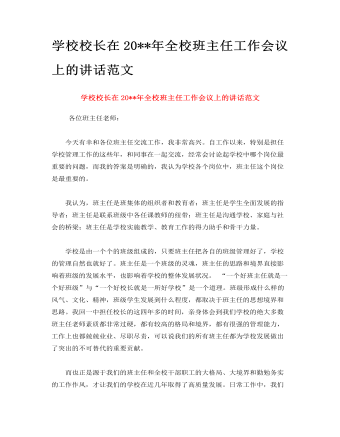
学校校长在2023年全校班主任工作会议上的讲话范文
仁爱心。没有爱就没有教育。爱是教育永恒的主题,班主任老师只有以“仁爱”为核心,尊重、关心、爱护学生,才能成为一名合格的班主任、成为一名学生喜爱的班主任。教育是塑造人心灵和灵魂的伟大事业,热爱学生应该是教师厚重的职业底色。班主任的仁爱之心体现为真诚地尊重学生,体现为相信每个学生都能够成为有用之才。当我们的班主任老师真做到有仁爱之心了,我们就能从心底喜欢和认可我们的每一个学生,我们也就能得到学生更大的爱戴和信服,也就能达成“亲其师,信其道”的效果,在我们开展教育活动的时候,就能更好地走进学生的心灵深处,就会更加平和、有效。我们学校很多班主任、老师深受学校爱戴,分析这些班主任和老师就不难发现,仁爱心是这些老师身上共有的特点之一。
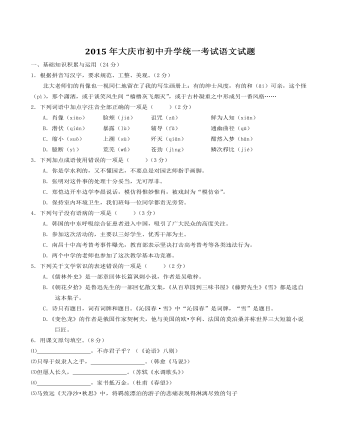
2015年中考真题精品解析 语文(黑龙江大庆卷)精编word版(原卷版)
①2014年年中,世界卫生组织(WHO)公布了《2013年全球气候状况报告》。报告显示,2013年全球陆地和海洋表面平均温度为14.5℃,比1961-1990年的平均温度升高0.5℃。自有温度记录以来,全球14个最热年份中有13个出现在本世纪,而过去30年中每个10年都比前十年更热。②厄尔尼诺是发生在热带太平洋上海温异常增暖的气候现象,大范围热带太平洋增暖会造成全球气候变化。进入20世纪70年代后,全球出现的异常天气,都有范围广、灾情重、时间长等特点,而在这一系列异常天气的背后,厄尔尼诺暖流都起着重要作用。
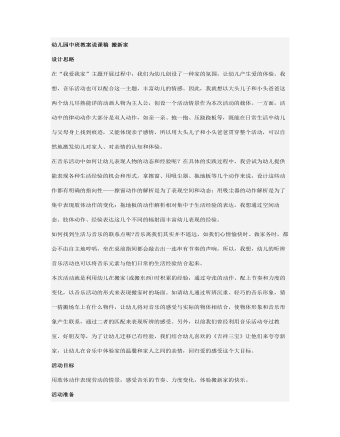
幼儿园中班教案说课稿 搬新家
在“我爱我家”主题开展过程中,我们为幼儿创设了一种家的氛围,让幼儿产生爱的体验。我想,音乐活动也可以配合这一主题,丰富幼儿的情感。因此,我就想以大头儿子和小头爸爸这两个幼儿耳熟能详的动画人物为主人公,创设一个活动情景作为本次活动的载体。一方面,活动中的律动动作大部分是双人动作,如亲一亲、抱一抱、压跷跷板等,既能在日常生活中幼儿与父母身上找到痕迹,又能体现亲子感情,所以用大头儿子和小头爸爸贯穿整个活动,可以自然地激发幼儿对家人、对亲情的认知和体验。
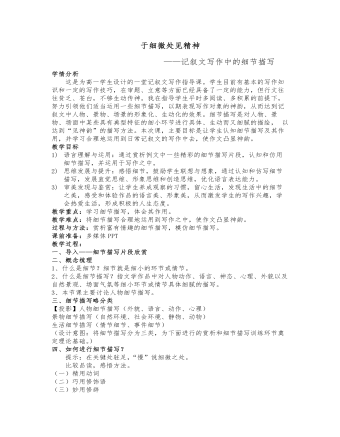
高中语文作文课教案说课稿模板
教学目标1) 语言理解与运用:通过赏析例文中一些精彩的细节描写片段,认知和仿用细节描写,并运用于写作之中。2) 思维发展与提升:感悟细节,鼓励学生联想与想象,通过认知和仿写细节描写,发展直觉思维、形象思维和创造思维,优化语言表达能力。3) 审美发现与鉴赏:让学生养成观察的习惯,留心生活,发现生活中的细节之美,感受和体验作品的语言美、形象美,从而激发学生的写作兴趣,学会热爱生活,形成积极的人生态度。
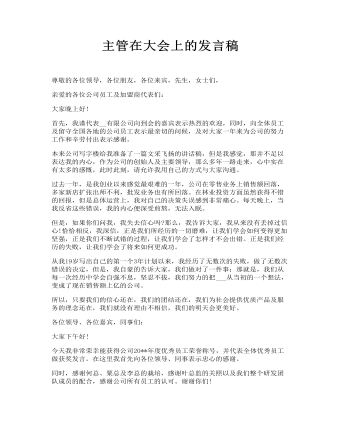
主管在大会上的发言稿
公司成立伊始,我便有幸加入到这个团队,几年来,我并没有为公司做出惊天动地的大贡献,更没取得特别值得炫耀可喜的成绩,我只是努力做好自己的本职工作,尽自己的能力尽快的去完成每一次任务,总结自己的经验,从经验中学习,在失败中成长。当选为优秀员工让我们觉得很自豪与光荣,它印证了我们工作的进步和成绩。同时它也是一种动力,促使我们更加勤奋与努力,去更好地完成每一件事情,为公司创造更大的效益。
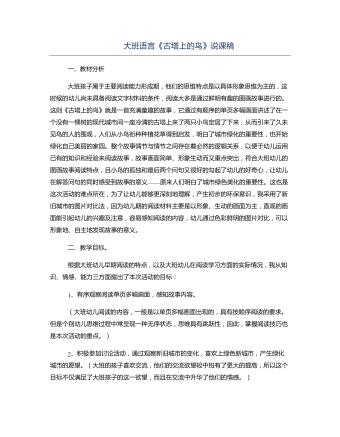
大班语言《古塔上的鸟》说课稿
二、教学目标。根据大班幼儿早期阅读的特点,以及大班幼儿在阅读学习方面的实际情况,我从知识、情感、能力三方面提出了本次活动的目标:1、有序观察阅读单页多幅画面,感知故事内容。(大班幼儿阅读的内容,一般是以单页多幅画面出现的,具有按顺序阅读的要求。但是个别幼儿思维过程中常呈现一种无序状态,思维具有跳跃性,因此,掌握阅读技巧也是本次活动的重点。)2、积极参加讨论活动,通过观察新旧城市的变化,喜欢上绿色新城市,产生绿化城市的愿望。(大班的孩子喜欢交流,他们的交流欲望较中班有了更大的提高,所以这个目标不仅满足了大班孩子的这一欲望,而且在交流中升华了他们的情感。)3、能与同伴合作用剪贴的方式创建新城市,增强合作剪贴能力。(这是本次活动的能力目标。)三、教学方法。根据纲要精神:要创造一个自由、宽松的语言交往环境,支持、鼓励、吸引幼儿与教师、同伴或其他人交流的乐趣,所以我在本次活动中采用了讨论交流法,讨论能开拓幼儿的思维,是激发幼儿言语的重要方法,而交流是幼儿学习阅读和检验阅读能力的基本手段。我在幼儿熟悉故事情节的基础上,让他们讨论交流,进一步感受故事的意义所在,不仅充分发挥了教育中的幼儿同伴资源,更让幼儿体验到了与他人交谈、交流语言的乐趣。纲要指出:教育不是让幼儿重复经验,而是把幼儿的已有经验重组和改建,所以教师要了解幼儿的现有经验,然后帮助他们整理、迁移、提升经验。在本次活动中,我就运用了经验迁移法,在了解幼儿喜欢绿色以及知道绿色对人类的好处的基础上我把这些已有经验迁移到故事中,让幼儿明白小鸟孤独的原因,揭示为什么最后人们会给自己的城市绿色美化的背后含义。
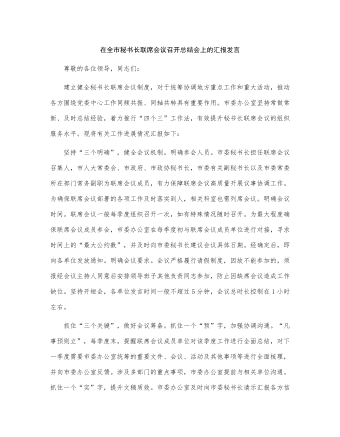
在全市秘书长联席会议召开总结会上的汇报发言(1)
当好“三个角色”,落实会议决定。当好工作落实的“推动者”。会后,联席会议成员单位及时向有关市级领导同志汇报会议研究的事项。市委办公室按会议要求督促跟进抓好落实,阶段性汇报工作推进情况。如,2022年第三季度联席会议提出,市委办公室、市委宣传部、市委政法委等单位要相互协调配合,共同做好重要紧急信息报送工作。会后,我们立即联合会商,研究健全全市重要紧急信息报送联动机制,并组织专题培训班,进一步提升重要紧急信息报送质效。当好工作安排的“调度员”。市委办公室认真研究、吸纳会上各单位提出的意见建议,按照会议部署的工作要求,对当前季度市委工作计划和活动预案进行优化调整,按照“月调度、周部署、日安排”方式高效调度,有序推动全市各项工作。


